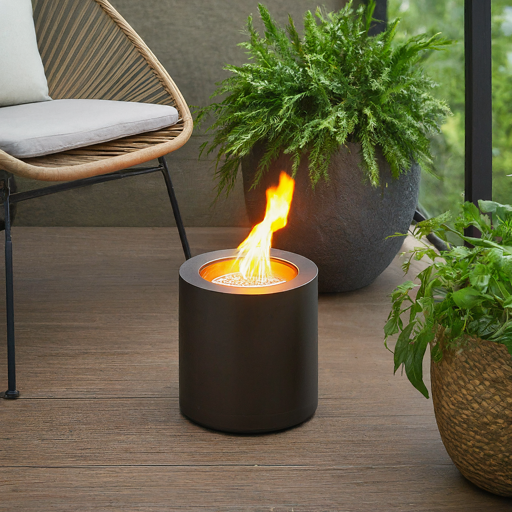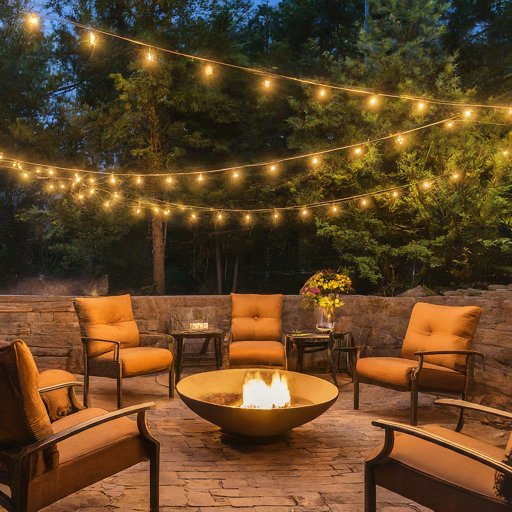Fire pits are a fantastic addition to any backyard, offering a cozy and inviting atmosphere for gatherings, relaxation, and even cooking. Whether you’re a novice looking to add a fire pit to your outdoor space for the first time or someone looking to upgrade their existing setup, this guide will walk you through everything you need to know to create a safe, functional, and aesthetically pleasing fire pit area.
1. Types of Fire Pits
There are several types of fire pits to choose from, each with its own set of advantages and considerations. Here’s a breakdown of the most common types:
Wood-Burning Fire Pits
Advantages:
- Traditional and rustic appeal.
- Produces a natural, crackling fire.
- Great for cooking and toasting marshmallows.
Considerations:
- Requires a steady supply of firewood.
- Can produce smoke and sparks, necessitating careful placement and monitoring.
- Needs regular cleaning to remove ash and debris.

Gas Fire Pits
Advantages:
- Easy to light and control with a simple switch or remote.
- Burns cleanly with no smoke or ash.
- Available in both natural gas and propane options.
Considerations:
- Requires a gas line installation or propane tank.
- Generally more expensive upfront compared to wood-burning pits.
- Limited to decorative use; not suitable for cooking.

Gel Fuel Fire Pits
Advantages:
- Portable and easy to use.
- No need for a gas line or firewood.
- Produces a clean, smokeless flame.
Considerations:
- Gel fuel canisters can be costly and need regular replacement.
- Smaller flame compared to wood or gas fire pits.
- Mostly decorative and not ideal for cooking.

2. Choosing the Right Location
Selecting the appropriate location for your fire pit is crucial for safety and enjoyment. Here are some key factors to consider:
Safety First
- Ensure the fire pit is at least 10 feet away from any structures, trees, or flammable materials.
- Avoid placing the fire pit under overhanging branches or a roof.
- Check local regulations and codes regarding fire pit placement and use.
Accessibility
- Position the fire pit where it can be easily accessed from the house and other outdoor areas.
- Consider the wind direction to avoid smoke blowing into seating areas or the house.
Aesthetic Appeal
- Choose a spot that enhances the overall landscape design of your backyard.
- Integrate the fire pit into existing patios, decks, or garden features for a cohesive look.

3. Building and Installing Your Fire Pit
Whether you choose to buy a pre-made fire pit or build one from scratch, proper installation is key to a safe and functional setup.
DIY Fire Pits
Materials Needed:
- Fire bricks or pavers
- Sand or gravel
- Steel fire ring (optional)
- Shovel and level
Steps:
- Choose Your Site: Mark out the desired location and clear the area of grass, roots, and debris.
- Dig a Hole: Dig a shallow hole about 6-12 inches deep and fill it with a layer of sand or gravel for drainage.
- Lay the Base: Arrange the first layer of fire bricks or pavers in a circle, ensuring they are level.
- Build Up the Walls: Continue stacking the bricks or pavers, staggering the joints for stability, until you reach the desired height.
- Add the Fire Ring: If using a steel fire ring, place it inside the brick circle for added durability.

Pre-Made Fire Pits
Advantages:
- Quick and easy to set up.
- Available in a variety of styles and materials.
- Often includes additional features like spark screens and cooking grates.
Installation Tips:
- Follow the manufacturer’s instructions for assembly and placement.
- Ensure the ground is level and stable before installation.
- Consider adding a heat-resistant mat or pad underneath the fire pit to protect your patio or deck.

4. Safety and Maintenance
Keeping your fire pit safe and well-maintained is essential for long-term enjoyment.
Safety Tips
- Always keep a bucket of water, hose, or fire extinguisher nearby when using the fire pit.
- Never leave the fire unattended, especially with children or pets around.
- Use a spark screen to prevent embers from escaping.
- Avoid using flammable liquids to start or maintain the fire.

Maintenance Tips
- Regularly remove ash and debris from the fire pit.
- Check for signs of wear and tear, such as cracks in the bricks or rust on metal parts.
- Store gel fuel canisters and propane tanks in a cool, dry place away from the fire pit.
- Cover the fire pit when not in use to protect it from the elements.

5. Enhancing Your Fire Pit Area
Once your fire pit is installed, consider adding some finishing touches to create a comfortable and inviting space.
Seating
- Arrange seating around the fire pit in a circular or semi-circular pattern for optimal warmth and conversation.
- Choose weather-resistant furniture like Adirondack chairs, benches, or cushioned outdoor sofas.

Lighting
- Add string lights, lanterns, or torches to create a magical evening ambiance.
- Use solar-powered path lights to illuminate walkways leading to the fire pit area.

Decorative Elements
- Incorporate outdoor rugs, throw pillows, and blankets for added comfort and style.
- Add potted plants, garden sculptures, or decorative stones to enhance the aesthetic appeal.

Conclusion
A well-designed fire pit can transform your backyard into a year-round haven for relaxation and entertainment. By choosing the right type of fire pit, selecting an appropriate location, and ensuring proper installation and maintenance, you can enjoy the warmth and beauty of a fire pit safely and stylishly. Whether you’re roasting marshmallows with family or hosting a gathering with friends, your fire pit will undoubtedly become a cherished focal point of your outdoor space.
Leave a Reply